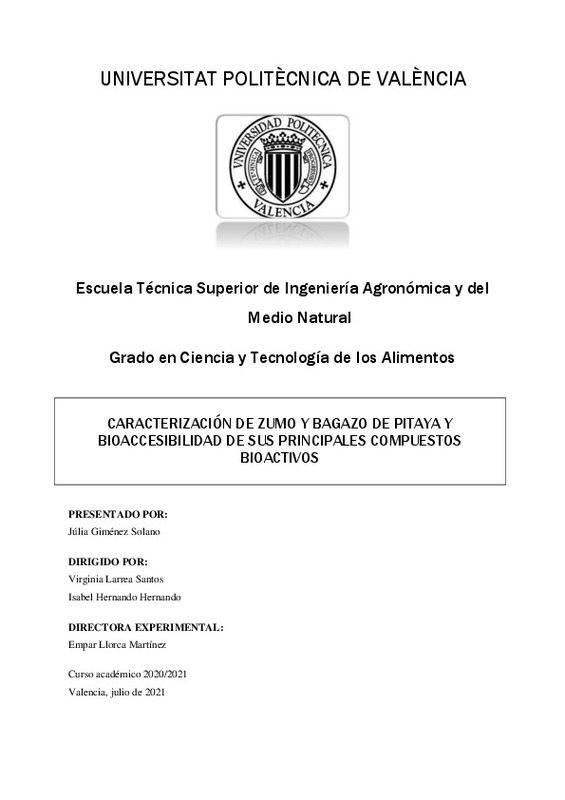|
Resumen:
|
[ES] La pitaya amarilla (Selenicereus megalanthus) se ha convertido en uno de los principales productos
exóticos de exportación de Colombia. Se trata de una fruta exótica que es consumida principalmente en
fresco, que ...[+]
[ES] La pitaya amarilla (Selenicereus megalanthus) se ha convertido en uno de los principales productos
exóticos de exportación de Colombia. Se trata de una fruta exótica que es consumida principalmente en
fresco, que contiene una gran cantidad de propiedades saludables para el cuerpo humano; es rica en
polifenoles, lo que la convierte en una buena fuente de compuestos bioactivos antioxidantes; y presenta
un alto contenido en fibra, sobre todo en las semillas. Sin embargo, el cultivo de la pitaya presenta un
inconveniente: la gran cantidad de excedentes generados en los meses de alta producción. Es posible
aprovechar estos desperdicios, pues las propiedades fisicoquímicas del fruto permiten su uso para la
transformación industrial.
Este trabajo tiene como objetivo la caracterización del zumo de pitaya amarilla y del bagazo resultante
de la extracción del mismo. Para ello se determina su contenido en compuestos funcionales (compuestos
fenólicos, carotenoides, vitamina C y fibra dietética), y su capacidad antioxidante. Se realiza también
una caracterización microestructural y se estudia la bioaccesibilidad de algunos compuestos bioactivos
tras la digestión in vitro. Los resultados obtenidos muestran que tanto el zumo como el bagazo de la
fruta contienen compuestos bioactivos en diferentes concentraciones. La concentración más alta de
cenizas, acidez, fibra dietética total, vitamina C, polifenoles y capacidad antioxidante se encuentra en
el bagazo, mientras que el zumo presenta una mayor bioaccesibilidad de los compuestos bioactivos tras
la digestión in vitro.
[-]
[EN] The yellow dragon fruit (Selenicereus megalanthus) has become one of Colombia's main exotic export
products. It is an exotic fruit that is mainly consumed fresh, containing a large number of healthy
properties for ...[+]
[EN] The yellow dragon fruit (Selenicereus megalanthus) has become one of Colombia's main exotic export
products. It is an exotic fruit that is mainly consumed fresh, containing a large number of healthy
properties for the human body; it is rich in polyphenols, which makes it a good source of antioxidant
bioactive compounds; and it has a high fibre content, especially in the seeds. However, the cultivation
of pitaya dragon has a drawback: the large amount of surpluses wastes generated in the months of high
production. It is possible to take advantage of this waste, as the physicochemical properties of the fruit
allow its to be used for industrial processing.
The aim of this work is to characterize the yellow pitaya dragon fruit juice and the pomace resulting
from its extraction. The content of functional compounds (phenolic compounds, carotenoids, vitamin C
and dietary fibre) and their antioxidant capacity are determined. A microstructural characterization is
also carried out and the bioaccessibility of some bioactive compounds after in vitro digestion is studied.
The results obtained show that both fruit juice and pomace contain bioactive compounds in different
concentrations. The highest concentration of ash, acidity, total dietary fibre, vitamin C, polyphenols and
antioxidant capacity is found in pomace, while juice shows higher bioaccessibility of bioactive
compounds and higher antioxidant capacity after in vitro digestion.
[-]
|







